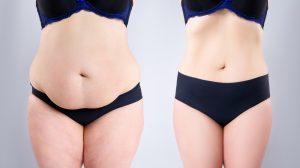Abdominoplasty Dubai (tummy tuck) is an operation that is designed to reshape the abdomen.
Often, through weight gain and loss, pregnancies and aging, the skin stretches beyond its elastic limit or ability to return to normal shape. An abdominoplasty removes excess skin and fat while the underlying muscles are tightened.
The actual placement of incisions and design of the abdominal incisions vary depending on the looseness of the underlying tissues. Also the amount of fat to be removed, the condition of the overlying skin and prior scars.
For those women where the sagging skin is mainly in the lower abdomen the mini-abdominoplasty is an additional option. As a result, this procedure is not as extensive due to a smaller incision that is easily hidden under a two piece bathing suit. This procedure offers a more rapid recovery and may be done on an outpatient basis.
A Patient’s Guide to Abdominoplasty Dubai
Dr. Matteo Vigo is a member of the International Society of Aesthetic Plastic Surgery (ISAPS). The the world’s leading professional body for board-certified aesthetic plastic surgeons.
Depending on the patient’s aesthetic objective. Dr. Vigo will recommend one of the following three types of tummy tucks available:
FULL OR CLASSIC ABDOMINOPLASTY DUBAI
A Classic Tummy Tuck (which are also referred to as full tummy tucks) is utilized when individuals want to address the sections above and below their belly button. The full length of the abdominal wall.
Many patients who opt for a full tummy tuck often want to resolve general roundness and excess skin. With this procedure, one horizontal or u-shape incision, and possibly a second incision, are made above the pubic area and the belly button. Respectively, to remove excess skin and tighten muscle. Full tummy tucks present the most natural-looking outcome, and can include a much firmer abdomen.
ABDOMINOPLASTY DUBAI – MINI TUMMY TUCK
All Mini Tummy Tucks involve less extensive incisions compared to a full tummy tuck. They are intended to improve only the lower belly, below the patient’s belly button.
This makes the procedure ideal for people who want to rid their bellies of a “pooch”. A tiny bulge or stretch marks in the lower abdominal region only. Dr. Vigo can tighten loose muscles through a single low horizontal incision. (Typically without an incision around the belly button). And also remove excess lower abdominal skin, resulting in a firmer, smoother lower belly.

Abdominoplasty Dubai
ABDOMINOPLASTY DUBAI – EXTENDED TUMMY TUCK
The extended tummy tuck is considered when the goals of the procedure are to address the abdomen while simultaneously targeting the flanks and hips.
To perform this procedure, Dr. Vigo extends the horizontal incision more laterally as well as often incorporating a longer, vertical incision, which enables the surgeon to remove excess skin from the upper and lower abdominal region as well as the flanks while tightening the abdominal wall.
This procedure is often ideal for those patients who have had multiple pregnancies or have lost lots of weight, either through diet and exercise or through weight loss surgery.
When it comes to an Abdominoplasty Dubai, I frequently explain to patients that the procedure is not a single surgical step, but rather a series of elements that can be combined to create customized results.
Liposuction focuses solely on removing unwanted fat cells from the body – such as those that create a noticeable bulge at the belly – an Abdominoplasty Dubai is intended to create sleeker contours by addressing any number of conditions that keep the abdomen from looking toned.
Excess fat
Of course, stubborn pockets of fat are an obvious culprit when it comes to a larger waistline. While liposuction is frequently performed as a standalone procedure, it can also be used as part of a Abdominoplasty Dubai to help flatten the area.
For this element, just about everything is handled as it would be for a solo lipo procedure: Fat is loosened and suctioned out via a cannula. The difference is that while liposuction requires small incisions that are later sutured closed, the incision made for a tummy tuck allows the surgeon access.
Excess skin
While extra fat causes bulges, extra skin creates a sagging pouch that can hide even well-defined abdominal muscles that sit beneath.
The amount of excess tissue can range from a little to a lot (sometimes referred to as an “apron”). For a tummy tuck, the surgeon essentially re-drapes the abdominal skin so that it sits flat and tight, then trims away the excess. The incision and subsequent sutures for this element are typically hidden lower on the torso, where they can be covered by a swimsuit bottom or underwear.
Lax muscles
Over time, belly muscles and their covering fascia can become loose.
Whereas firm fascia holds everything in place – something like interlaced fingers keeping a water balloon from bulging outward – lax fascia allow the contents behind to bulge outward. Abdominal muscles can separate, giving the entire midsection a flabby look.
During an Abdominoplasty Dubai, Dr. Vigo can, if necessary, stitch these muscles and fascia back together to make everything tight and toned. In some cases, as with a mini-tummy tuck, this may be the primary element of the procedure. It is often chosen by moms who have a small bulge that sits below the belly button.

Abdominoplasty Dubai
Belly button placement
Depending on the tummy tuck details, the surgeon may need to “relocate” the belly button, which involves creating a hole in the newly taut abdominal skin. This is so the navel appears where it should to remain proportional with the rest of the body. This is called “umbilical translocation.”
Following this, the body can be further contoured to encourage an hourglass shape by creating an “internal corset.” I have performed measurements that show narrowing of the waist and improvement of the waistline due to work at this stage.
When all of the steps are completed, the incision will be closed with either a special glue or absorbable sutures. This is such that the patient can take a shower the next day and there is no need to remove the sutures. Lasers can be used post-operatively to hasten the healing of scars. Also, use of Exparel injections numb the abdomen for three days, which can minimize pain for patients.
Every patient has a unique body shape and size
Since every patient has a unique body shape and size, as well as personal goals for an ultimate look, each tummy tuck is its own procedure. While there are commonalities between all such surgeries, no two will be exactly alike.
The most common form of tummy tuck involves a horizontal incision near the pubic hairline, so swimwear or undergarments can hide the resulting scar. If there is excess skin above the navel, an incision around the navel may be required.
Sometimes, the surgery involves liposuction to remove pockets of excess fat from specific areas of the body. To reduce scar tissue and increase the speed of healing, I may utilize a harmonic scalpel. This uses ultrasonic energy to perform parts of the tummy tuck surgery. Diastasis is a term used to describe the separation of the two-paired abdominal muscles that make up the front of the abdomen, which is often caused by multiple pregnancies.
Sutures are used to tighten up the abdominal wall, resulting in a flatter stomach. Stronger, tighter abdomen muscles may also help reduce lower back pain.
Abdominoplasty Dubai is not a shortcut to weight loss
This is not a shortcut to weight loss. But, it can be a powerfully transforming surgery and complements the impact that weight loss has on the abdominal profile. Many of our patients say they feel liberated after having a tummy tuck.
They can wear a bikini again, or not wear a shirt or a top to cover up their loose stomach. They feel good about being outdoors running, swimming and golfing. It does a lot to boost a person’s confidence in their bodies and for many of my patients. It’s an incentive to maintain a healthy appearance for the rest of their lives.
For some patients, tighter abdomen muscles may also help reduce lower back pain.
DETERMINE WHICH PROCEDURE IS RIGHT FOR YOU
Deciding which procedure is right for you will be contingent upon several factors and is best done in consultation with an experienced Plastic Surgeon. Some of them include your desired results, overall skin quality, body type and location of excess skin on the body.
The amount of excess skin will also determine which procedure is most appropriate. Finally, any scarring attained from a previous cosmetic procedure or surgery can determine which kind of tuck the patient qualifies for.
THE RECOVERY
You’ll want to figure out a time frame for your recovery so you have ample time to heal and can take a break from certain aspects of your life. Make sure you make the proper arrangements and are fully prepared for your recovery period.
Your drains will be left in for a few days after the surgery. You’ll be shown how to take care of and empty the drains. You’ll likely need to take an antibiotic and an anticoagulant while your drains are in place.
You’ll wear an abdominal binder for about six weeks. This helps to avoid fluid buildup and helps to support your abdomen.
While the recovery period is usually shorter for a mini-tummy tuck. You’ll still need to avoid strenuous activity for at least six weeks. This includes any vigorous exercise or heavy lifting.
Who is a Candidate?
- Women with loose or sagging abdominal wall skin.
- Women with abnormal relaxation of the anterior (front) abdominal wall muscles due to weight gain or loss, pregnancies, or prior surgery.
- Those who are unable to tighten the abdominal wall skin with exercise.
Intended Results
- A smoother flatter abdomen.
Procedure Description
- The procedure is usually performed at an accredited outpatient facility or hospital.
- Anesthetic options include local anesthesia with oral sedation, conscious sedation and general anesthesia.
- Mini-abdominoplasty can usually be performed under conscious sedation on an outpatient basis.
- Standard abdominoplasty tightens all of the abdominal wall skin leaving a standard scar.
- Mini-abdominoplasty tightens the lower abdominal wall skin only leaving a shorter scar.
- Small suction drains may be inserted with both procedures.
Recuperation and Healing
- Discomfort is usually controlled with oral medications or nasal spray.
- Recovery may be at home with a responsible adult caregiver, at a supervised recovery facility or at the hospital with an overnight stay.
- If placed, drains are removed in 2-7 days.
- Sutures are usually removed in 2-3 weeks.
- A compression garment with dressings over the incision sites is used.
- Light activity may be resumed in 7-21 days. Sports will probably not be comfortable for about 6 weeks.
- An abdominal binder (compression garment) is usually worn for 4-6 weeks.
Other Options
- Liposuction-liposculpture of the area.
Note
Abdominoplasty Dubai – The specific risks and the suitability of this procedure for a given individual can be determined only at the time of consultation. All surgical procedures have some degree of risk. Minor complications that do not affect the outcome occur occasionally. Major complications are rare.
